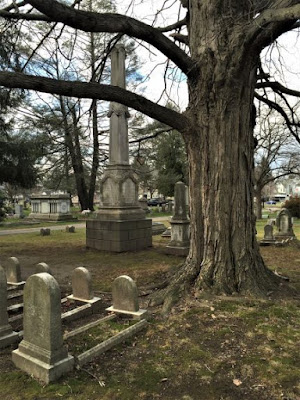Now there’s a catchy title, don’t you think? Read on and you will learn all. This week is the anniversary of an incident that poisoned the well for me - the week in 1972 when I explored the cemetery in Forty-Fort, PA, after Hurricane Agnes destroyed it. If you'd like to read this chilling account of what (I believe) led to my lifelong interest in dead things, the full account serves (I think appropriately) as the introduction to my book, “The Cemetery Traveler.” It is available on Amazon. Not for the faint of heart, I might add. Graveyards are not always fun. Sometimes they're a true horror story.
When I was fourteen (1972), Hurricane Agnes caused major flooding in Northeast Pennsylvania. After sandbagging the Susquehanna River dike all day in front of my grandmother’s house, the rising river water blew out of the street storm drains like geysers. This caused some minor flooding, but it wasn't enough to equalize the water pressure--the dike at the cemetery in the town of Forty-Fort blew out. Not only was the Wyoming Valley under sixteen feet of water for days, but the cemetery was gutted.
 |
| Forty-Fort Cemetery after the 1972 flood (ref.) |
When the flood waters receded, the U.S. Army Corps of Engineers made some major repairs, facilitated a massive cleanup, and boarded up the cemetery. Rumors had it there were coffins everywhere! As a teenage boy, this is exactly the cool stuff you want to hear. Later, there were photos published in newspapers showing coffins lodged on the front porches of homes in my neighborhood.
 |
| Street cleaning, post-flood 1972 (ref.) |
Most of this memento mori was removed before people were allowed back to their homes (after about ten days, I think). Until recently, I never knew exactly where they reinterred the human remains and coffins that were collected. You can read a grim account of the collection of caskets and bodies here.
So after a couple weeks, when residents were allowed back to their homes to facilitate their own massive cleanup, my cousin Albert and I wandered down to the cemetery, only to find 8-foot sheets of plywood attached to the existing wrought iron fencing. Hardly a deterrent, we went exploring. In not much time, we found a washed out space under one of the plywood sheets that was big enough for a boy to crawl under. Needless to say, that's what we did.
Nothing … could have prepared me for the … stench! Was it the bodies? The dead fish? The river mud baking in the hot summer sun? Probably a combination of both.
As we walked around the grounds that day in the late June heat, who would have thought the experience would affect me for a lifetime? You had to mouth-breathe just to keep from passing out from the assault on the nasal passages. The fetid aroma was no doubt accentuated by the heat, but oddly, you couldn't smell it from outside the plywood fencing.
I’d visited Forty-Fort Cemetery in 2016 - the first time since 1972. I’ve been there a few times since then. The tree in this photo is the very same tree I mention in the story – the one the object was propped up against. (You have to read the intro chapter of my book for further details.)
As a memorial to the 2700 bodies that were unearthed, a large monument was erected in the Forty-Fort Cemetery (shown above). The bodies that were found (one has to assume that many were washed away down river) were reburied elsewhere. The news and published accounts have always been scarce on details. Enter my friend Dorothy Loney!
 |
| Photo by Dorothy Loney |
Back in May 2020, Dorothy sent me some photos she took in Carverton, PA, a town in Wyoming County, Pennsylvania. It was a cemetery called Memorial Shrine Cemetery, about ten miles north of Forty-Fort. Apparently, this monument marks the mass grave where the collected remains for the Forty-Fort Cemetery were reburied. Back around 2010, I spoke with the caretaker of the Forty-Fort Cemetery, who I believe is the son of the gentleman who was the caretaker in 1972. He told me that he can remember his dad running from the office meeting house to his car, carrying armloads of burial records, as the river approached flood stage. As the water rose in the streets, but before the dike gave way, he said he remembered his Dad in knee-deep water carrying as many of the records as he could out of the office in an attempt to save them. I’m guessing some records were lost.
So the end of June will always bring to mind visions of my parents’ home with water up to the second floor, living with dried flood mud for the next year, the dust, the smell of dead fish, living in trailers, and the widespread devastation from which many of the flooded towns never recovered. The Wilkes-Barre, Pennsylvania area where I live is one of those. As the National Weather Service states: “The widespread flooding from this storm caused Agnes to be called the most destructive hurricane in United States history, claiming 117 lives and causing damage estimated at $3.1 billion in 12 States. Damage was particularly high in New York, Pennsylvania, Maryland, and Virginia." (Ref. https://www.weather.gov/bgm/pastFloodJune1972)
And as I look back on my years of cemetery traveling, photography, and writing, I suppose Hurricane Agnes was a muse, of sorts. If I hadn’t had that traumatic experience in the Forty-Forty Cemetery, you would not be reading this blog.
I leave you with a marvelous photograph, one Dorothy Loney made of the chapel at the Memorial Shrine Cemetery. Deliciously creepy, is it not?
Further reading:
















